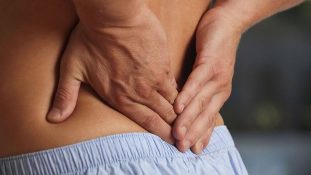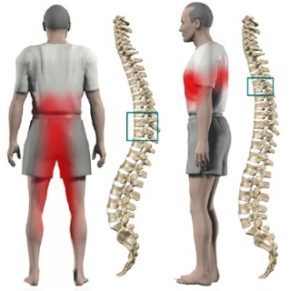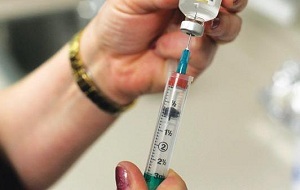Osteochondrosis of the lumbar spine, its symptoms and treatment vary, is one of the most common pathologies of the musculoskeletal system.
This condition is characterized by the fact that changes in degenerative-dystrophic nature develop in the intervertebral disc, spreading over time to the ligaments and vertebral bone tissue of the lumbosacral spine. The acute process, if there is no therapy, will definitely be a chronic process.
Degenerative diseases can turn a healthy person into a disabled person.
Degree of osteochondrosis of the lumbar spine
Classify 4 degrees of osteochondrosis of the lumbosacral region. The scheme of development of this disease is as follows:
First degree.Inside the fibrosus annulus, cracks form, where the contents of the nucleus pulposus penetrate, causing irritation. This is the early stage of osteochondrosis. Deformation of the intervertebral disc is almost invisible and provides reflex pain with sudden movement and weight lifting. Unpleasant sensations in the lower spine can be mild and obvious:

- lumbodynia - local and persistent pain in the lumbar spine;
- lumbago - "lumbago" that hurts suddenly in the lower back.
Second degree.The destructive process in the annulus fibrosus continues. The distance from one vertebra to another decreases, causing compression of nerve fibers. There is discomfort in the lower third of the back, which sometimes develops into pain.
Third degree.During this period, the final destruction of the fibrosus annulus occurs by extrusion of the nucleus pulposus. Vessels and nerve endings are compressed by intervertebral discs. An intervertebral hernia is formed. Curved spine, forming:
- lordosis - arcuate deformity of the lumbar spine, with anterior protrusion of the spine;
- kyphosis - the position opposite to lordosis, when the bow is formed in the outer direction;
- scoliosis - bending pathology of the spine to the right or left.
Osteochondrosis of the last degreeis considered the most severe and dangerous. By this time, the spine is deformed, normal motor activity is lost. X-rays show bone growth in the lumbar spine - the body's response. Pain may not be present for a while, but this does not mean an increase. People suffering from stage 4 osteochondrosis of the sacro-lumbar spine often become disabled. The reason is that at this stage the process is complicated.
Causes of lumbar spine osteochondrosis
Among the causes of lumbar osteochondrosis are the following:
- Unbalanced load on the spine.Humans are upright beings, therefore, in a standing position, the load on the spinal space is considered normal. While performing various actions, you should move, bend and not bend. To keep the body in the desired condition, the musculoskeletal system is in a state of prolonged tension. In the sitting position, the load on the spinal space increases, and when lying on the back, it becomes minimal. When a person is in a position for a long time, the lumbar and sacral spine parts are excessive and the muscles do not rest, from which discomfort first arises, and then pain. These deforming factors create prerequisites for the development of lumbar spine osteochondrosis.
- Inactive lifestyle.This contributes to the development of various pathologies, including those affecting the structure of the vertebrae. Prolonged sitting causes deformation of cartilage tissue and decreased muscle tone, provoking the development of lumbar osteochondrosis.
- Excessive physical exercise.Lack of vigorous physical activity and its advantages do not bring anything good for the musculoskeletal system. Prolonged hard work, especially related to lifting and carrying weights, causes excessive back muscle tension and leads to the formation of vertebral hernias.
- Posture disorders.Disc deformation between vertebrae can also be caused by improper running. The reason again is the uneven load on the spinal space. The intervertebral disc loses elasticity, mobility, and is therefore more likely to be damaged. More than anything else, the elderly and the elderly experience similar problems.
- Bone defects, hereditary pathologies, trauma and infectious wounds.Often, osteochondrosis is the result of a disorder of the musculoskeletal system present at birth. For example, when the cartilage tissue of the body is naturally fragile. In addition, spinal pathology develops after traumatic injuries and infectious processes, such as in osteomyelitis and tuberculosis.
- Kaki rata."Special" foot marks - the absence of notches and drooping curves. Those with such characteristics often face spinal problems. This is due to the increased load on the intervertebral disc while walking. Throughout life, they experience increased physical stress while moving, so they run out quickly
- Obesity.Being overweight is an additional problem and burden for the body. All organs and systems suffer, including the spine.
- Pathological process.Multiple structural dysfunction can adversely affect the state of the musculoskeletal system. Thus, the factors that provoke lumbar spine osteochondrosis are endocrine disorders, cardiovascular problems and damage to the digestive system.
- Wrong way of life.Many people do not pay enough attention to simple and important things like physical activity, a balanced diet and normal sleep. Organisms that exist for a long time in a state of stress become weak and vulnerable. Among other pathologies that can arise in "fertile" soils, include lumbar osteochondrosis.
Symptoms of lumbar spine osteochondrosis

Pathological changes in the lumbar spine are indicated by severe symptoms;
- Lower back painis the clearest "signal" about the development of lumbar osteochondrosis. He talked about the presence of "radicular syndrome", when compression of the spinal nerve endings causes pain in the lumbar region. The person becomes tired and irritable. Over time, doing moderate and routine activities becomes a major problem due to pain in the lumbar spine. If an intervertebral hernia has formed in the lumbar region, the pain radiates to the lower legs, back of the thighs and legs. Over time, it becomes more difficult to sit and walk. Unpleasant sensations will not be released even when lying down. Temporary relief can be replaced with deteriorating periods. ;
- genitourinary system dysfunction.They are manifested by pain in the kidney area, often urging to urinate. Deformation of the intervertebral disc causes displacement of the lumbar spine relative to the sacrum. This affects the work of the internal reproductive organs in women, and in men causes problems with potency;
- decreased foot sensitivity in the foot area.It can be partial or absolute. At the same time, the reflexes of this part of the body become weak. Progressive pathology leads to complete loss of sensitivity of the lower extremities;
- walking disorder.Pain in the lumbar spine with osteochondrosis makes a person when walking to deviate in the opposite direction to the one where the nerve fibers are pinched. This situation does not allow long walks. People who are paralyzed have to stop from time to time, hoping for pain relief. Timely medical help can save a person from disability.
Treatment of lumbar spine osteochondrosis
Many people wonder if lumbar spine osteochondrosis is treated and how it occurs. Once a diagnosis is made and a diagnosis is made, therapeutic tactics are determined.
There are various methods used to treat lumbar osteochondrosis. Which is necessary and recommended to use to cure the disease or alleviate a person's condition as much as possible, the doctor determines.
Someone treats themselves exclusively with folk remedies, at home, forgetting that it can be used only with the consent of a physician and only as part of a complex therapy.
Remedy for osteochondrosis
Drug therapy involves the use of:
- tablet form;
- injection solution;
- preparations for external use - ointments and gels.
Medication is prescribed to relieve inflammation and relieve pain in the lumbar spine. They can be used at home.

This is possible:
- analgesics;
- non-steroidal anti-inflammatory drugs;
- medication for muscle cramps (muscle relaxer);
- means recovery of cartilage tissue (chondroprotectors);
- corticosteroids (drugs that contain hormones that act to relieve pain and inflammation)
- vitamin.
The course of treatment is prescribed by a doctor, who sometimes prescribes tablets or ingredients to calm the nervous system as an additional treatment.
Physiotherapy for lumbar osteochondrosis
Physiotherapy is another common method of relieving the symptoms of lumbar osteochondrosis. Acts on the spine and lower back, it enhances metabolic and recovery processes.
Most frequently prescribed:
- magnets, lasers and electrotherapy;
- fonoforesis;
- shock wave method;
- detensor therapy;
- vibration massage;
- balneotherapy.
How much and what procedure is needed - the doctor decides.
Physiotherapy is effective when entering the early stages of pathology. But he, like other types of treatment, has contraindications. Therefore, when prescribing this method, the doctor takes into account many factors.
Therapeutic gymnastics for lumbar osteochondrosis
A set of physical exercises that can be shown for lumbar osteochondrosis aims to restore this mobility of the spine.
Regularity is considered a key condition of its effectiveness. Occasional exercises will not bring the desired effect.
If the body is already experiencing complications caused by osteochondrosis, this method is not used. In addition, contraindications to its use are severe pathology of other organs and systems, as well as the presence of pain in the pelvic area and above.
Surgical intervention for lumbar spine osteochondrosis
Surgical methods are used if there are severe complications such as intervertebral hernias. Partial or complete removal of the damaged intervertebral disc (discectomy) is performed, as provided by the operating protocol.
The instructions for surgery are:
- strong and persistent pain syndrome, which cannot be removed with medication for a month;
- the size of a hernia and its effect on the spinal cord.
Osteochondrosis is easier to prevent than to cure. Like pathology, it is potentially dangerous with severe complications. It is important to understand that the removal of this pathology is more likely at an early stage, when the effects of deformation on the intervertebral disc are minimal. In other cases, we can only talk about relieving symptoms and maintaining body condition, which allows you to live and work normally.












































